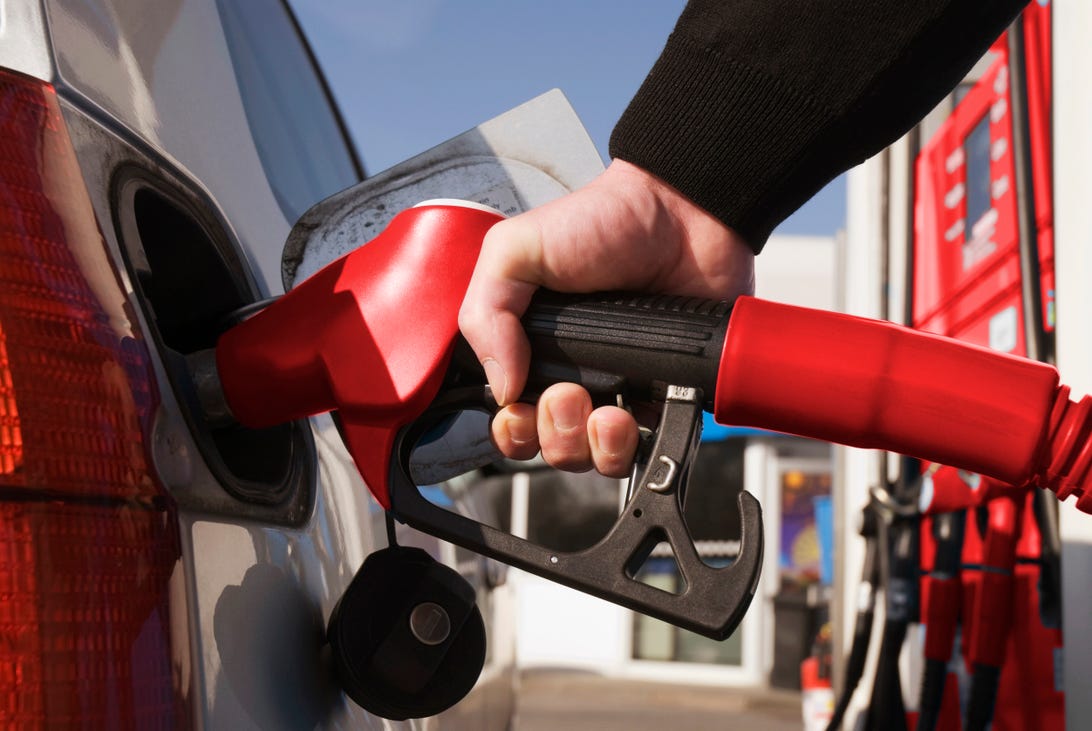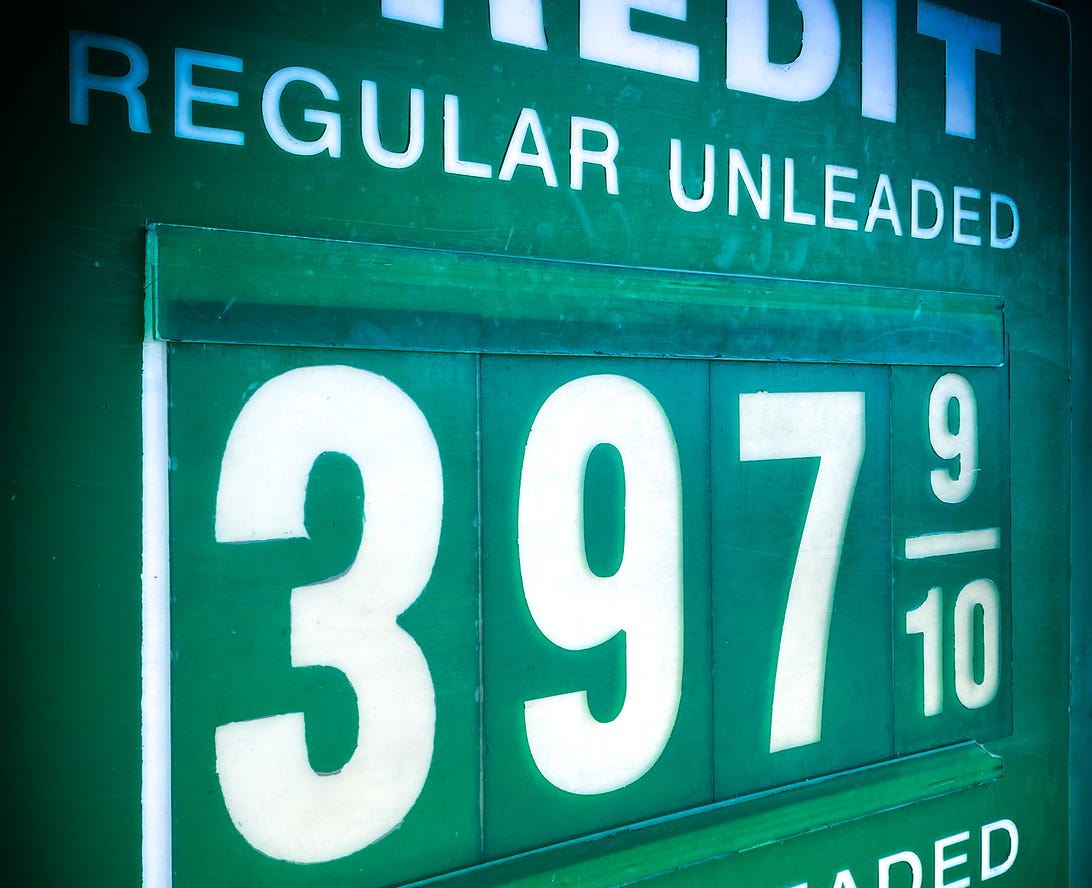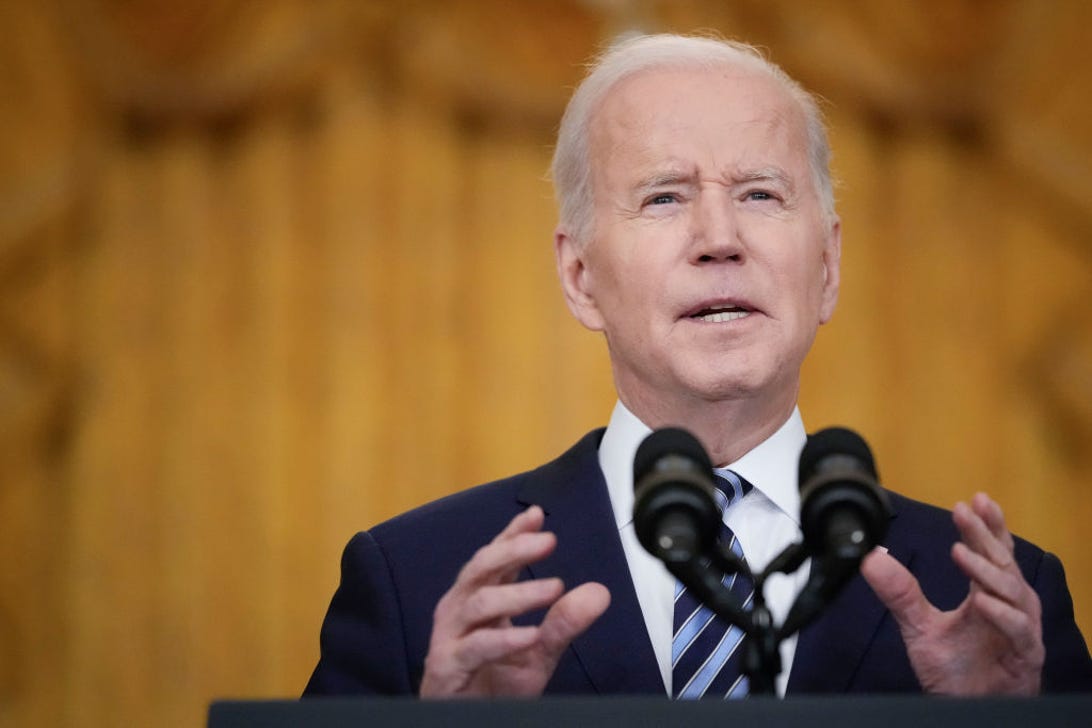

Prices at the pump in the US have risen 17% over the past month.
Getty Images
The average American gasoline price jumped another 9 cents on Saturday to $4.01 — the first time the price has gone above the $4 per gallon mark since 2008. As the cost of oil continues to rise, the average gas price is expected beat the all-time record of $4.11 in mere days.
Gasoline’s dramatic price spike has followed the Russian invasion of Ukraine. Since the military attacks began 11 days ago, the price of American gas has risen 13%, or 47 cents per gallon. California made news on Friday as prices pushed past $5 a gallon — the first time that’s happened in any US state ever.
Here’s what you need to know about gas prices, including how high they could go, how the Ukraine crisis and other factors are impacting them and what the Biden administration can do about it.
How high will gas prices go?
Prices on Saturday already average $5.29 a gallon in California and show no sign of slowing. Gas prices tend to rise in spring, as refineries undergo maintenance before the summer driving season.
In a statement on the US reaching the $4 per gallon mark, Patrick DeHaan, head of petroleum analysis at price tracker GasBuddy, warned, “As Russia’s war on Ukraine continues to evolve, and we head into a season where gas prices typically increase, Americans should prepare to pay more for gas than they ever have before.”

Average gas prices could easily hit $4 a gallon nationwide this month, analysts warn, and go even higher.
MCCAIG
The cost of gasoline is heavily influenced by the cost of crude oil, which it’s refined from. On Friday, the price of Brent crude, the international benchmark, settled at $118.11 a barrel, an increase of nearly 7% from Thursday.
By comparison, crude oil averaged about $74 a barrel in December 2021.
West Texas Intermediate crude, the US standard, rose 7.4% to settle at $115.68 — the highest since September 2008.
DTN senior market analyst Troy Vincent told CNET that “in a worst-case scenario, with Russian gas and oil fully cut from the global market,” crude could go up to $130 a barrel, or even higher.
Brent crude reached an all-time high of $147.50 in July 2008, fueled by a Brazilian oil worker strike and threats to supplies from Nigeria and Iran. At that time, average US gas prices peaked at $4.11 a gallon.
If crude goes that high in 2022, Vincent said, $6.50 or even $7 a gallon wouldn’t be out of the realm of possibility.
“At that point, though, it would trigger a global recession,” he added. “People would start limiting their activities to the bare essentials.”
Does the US get oil from Russia?
Russia is one of the world’s largest producers of crude and natural gas, providing 10% of the global supply and roughly 40% for the European Union.
While the US is the largest producer of crude oil and natural gas, it’s also the largest consumer, producing over 18.6 million barrels a day while using over 20.5 million.
Last year, the U.S. imported roughly 245 million barrels of crude oil and petroleum from Russia, almost 25% more than in 2020, making it our third largest outside source after Canada and Mexico. In November alone, about 595,000 barrels per day, or roughly 7%, came from Russia.

The US imports more crude oil than it produces, and Russia is our third-biggest source.
Frederic J. Brown/AFP via Getty Images
While the West has levied major economic sanctions against Russia over its invasion of Ukraine, only Canada has banned crude oil from the former Soviet Union. The US, Europe and other allies are hesitant to cut off access to a vital resource.
Eighty percent of Americans support the idea of banning Russian oil imports, according to a Reuters/Ipsos poll on Friday,
Both Republicans and Democrats in Congress have called for such a ban, but they have different solutions to fill the gap: A GOP-sponsored bill calls for increased drilling in the US, while a separate measure from Green New Deal supporter Sen. Ed Markey pushes renewables.
“Our global addiction to oil keeps us locked into dangerous cycles of conflict and corruption, but we can choose a cleaner path to peace,” Markey, a Democrat from Massachusetts, said in a statement.
What’s making gas prices soar?
“Russia’s invasion and the responding escalating series of financial sanctions by the U.S. and its allies have given the global oil market the jitters,” AAA spokesperson Andrew Gross said in a statement Monday. “Like the U.S. stock market, the oil market responds poorly to volatility.”
The spike in gas prices is “a grim reminder that events on the far side of the globe can have a ripple effect for American consumers,” Gross added.
But while the crisis in Ukraine is having an immediate impact, Vincent said it’s hardly the sole factor. “We’ve had a supply-and-demand imbalance for a while — and it will remain regardless of whether this conflict goes away,” he said.
As it has in every industry, the pandemic has caused staffing issues at refineries. And there have been outages — including a fire this week at a Marathon Petroleum plant in Louisiana.
A colder winter across North America has also led to higher demand for heating oil, and pandemic-driven online shopping has taxed diesel, which fuels all those trucks.
“Demand for diesel has been well above pre-COVID levels for months,” Vincent added. “High US e-commerce sales have meant all those shipments need to be delivered to homes.”
What can the White House do to lower gas prices?
President Joe Biden has promised a strategy to “blunt gas prices” in the face of the Russian incursion, including releasing oil from the Strategic Petroleum Reserve, a deep underground storage complex along the Gulf Coast that holds an estimated 600 million gallons of crude.
On Tuesday, the United States and other members of the International Energy Agency agreed to release 60 million barrels of oil from their strategic reserves, with 30 million coming from the US.

President Joe Biden is releasing barrels from the Strategic Petroleum Reserve to offset rising gas demand.
Brendan Smialowski/AFP via Getty Images
But many experts believe 60 million barrels — equal to about 12 days of Russian crude export — won’t make much of a ripple.
And the reserves being released are mostly light oil — the US mostly imports a heavier grade of crude from Russia. “You can’t always just swap out one for another easily,” Stewart Glickman, an oil analyst for CFRA Research, told CNBC.
There have been calls for the US to further invest in clean energy to wean us off dependence on foreign oil, but that would be a long-term strategy not likely to impact prices in the near future.
Some legislators have called for a suspension of federal and state gas taxes — a gas tax “holiday” — to help lower prices. But economists warn that would have no effect on the oil supply and only encourage consumers to drive more.
“It’s a way for politicians to pretend they are making the situation better, when in fact they are making it worse,” Maya MacGuineas, president of the Committee for a Responsible Federal Budget, wrote in an op-ed in The Hill last week.
How can consumers save at the gas station?
There’s not much we can do to change the price of gas, but drivers can cut down on unessential trips and shop around for the best price — even crossing state lines if it’s not inconvenient.
Apps like Gas Guru scan for the best gas prices in your region. Others, like FuelLog, track your car’s gas mileage and can help determine if it is getting decent fuel economy. In addition, many gas station chains have loyalty programs, and credit cards have rewards programs that give cash back for gas purchases.

Shop around for the best price in your town.
Dangubic/Getty Images
DTN’s Vincent advises against hoarding gas or other extreme measures but encourages budgeting more for gas. High energy prices have been a major contributor to inflation for a while, he said, and won’t be going away immediately.
“When the cost of crude rises, prices at the pump tend to reflect it very quickly,” he said. “But gas prices tend to linger higher longer even when crude falls.”